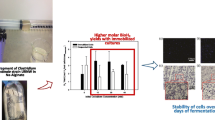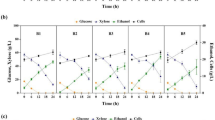Summary
The optimum conditions forAcetobacter immobilization were investigated. The results show that: 1) the maximum oxygen uptake rate (OURm) and cell release are related to alginate and cell concentration in the gel; 2)different alginate concentration does not affect cell viability, but long storage in CaCl2 reduces the number of living cells; 3)the double alginate gel layers had no influence on cell viability and on the OURm and prevented cell leakage from the gel matrix.
Similar content being viewed by others

References
Gosmann, B., and Rehm, H.J. (1988). Appl. Microbiol. Biotechnol.29, 554–559.
Scott, C.D. (1987). Enzyme Microb. Technol. 9, 66–73.
Author information
Authors and Affiliations
Rights and permissions
About this article
Cite this article
Fumi, M.D., Silva, A., Battistotti, G. et al. Living immobilized Acetobacter in Ca-alginate in vinegar production: Perliminary study on optimum conditions for immobilization. Biotechnol Lett 14, 605–608 (1992). https://doi.org/10.1007/BF01023949
Issue Date:
DOI: https://doi.org/10.1007/BF01023949



